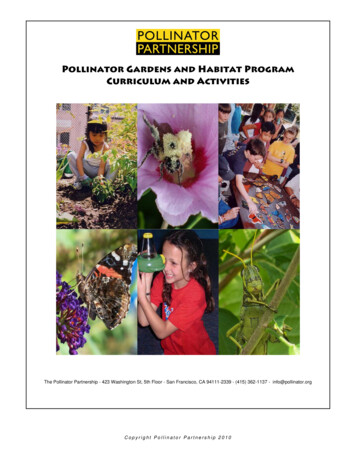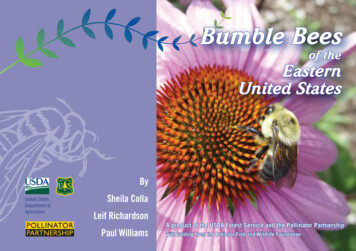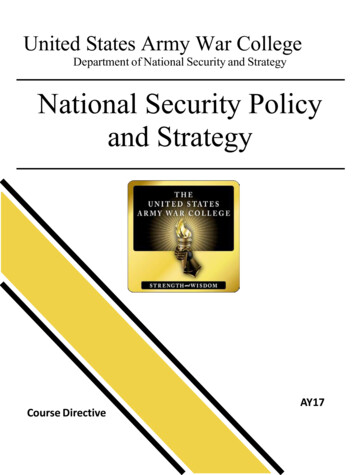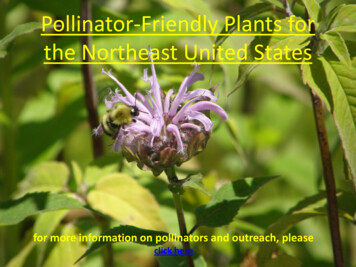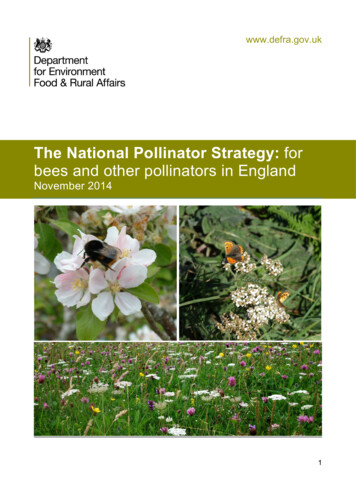
Transcription
www.defra.gov.ukThe National Pollinator Strategy: forbees and other pollinators in EnglandNovember 20141
Crown copyright 2014You may re-use this information (excluding logos) free of charge in any format or medium,under the terms of the Open Government Licence v.3. To view this licencevisit cence/version/3/ oremail PSI@nationalarchives.gsi.gov.ukThis publication is available at www.gov.uk/government/publicationsAny enquiries regarding this publication should be sent to us at:Pollinators and Plant Health Policy,Defra,Sand Hutton,York,YO41 1LZpollinatorstrategy@defra.gsi.gov.uk01904 406659PB142212
Foreword by the Secretary of State forEnvironment, Food and Rural AffairsThere are so many plants in our fields and gardens and in the wild that are so common wecan often take them for granted: apples, raspberries, oxeye daisies, foxgloves, oil seedrape, to name just a few.But they could not flourish without their pollen being spread by bees and hundreds ofspecies of other insects – hoverflies, wasps, moths, beetles and butterflies.If these pollinating insects went into serious decline, the health of our 100bn foodindustry, which is at the heart our economy, would be damaged. Without the servicenature provides, some of that food would become a lot harder to grow and moreexpensive.The beauty not just of our countryside but of our gardens and parks too would be severelyaffected. Britain would become a much more drab place.That is why taking action to help these insects is a key part of my priorities to improve thenatural environment and grow the rural economy.Pollinators face many pressures which have led to declines in numbers, and a reduction inthe diversity of species to be found in many parts of the country.That is why we are publishing this National Pollinator Strategy, which over the next 10years will build a solid foundation to bring about the best possible conditions for bees andother insects to flourish.It is a shared plan of action. By working together we will ensure pollinators’ needs areaddressed as an integral part of land and habitat management.To get to this stage we have been working hard with a range of organisations andscientists. I am enormously grateful to those who have worked with us so far. I am alsovery grateful to all of those who responded to the public consultation on the proposedStrategy, and to many of you for sharing examples of how you are already supportingpollinators.I am delighted that some of our largest landowners are committed to taking action tosupport pollinators on their land – the National Trust, the Forestry Commission, theMinistry of Defence, to name a few. I am also delighted that so many organisations (listedbelow) are already committed to working with us on implementation.Through this Strategy, we are also inviting the public, along with landowners, voluntarygroups, businesses, local authorities and other, to play their part. This will ensure we help3
pollinators across towns and cities as well as in the countryside; in window boxes, parksand gardens as well as hedges, woods and fields.A particular challenge in developing proposals for action is uncertainty over the currentcondition of pollinators. There are questions over the impact the threats against them arehaving. There are also questions over how resilient agricultural and natural systems are tochanges in pollinator populations. An important part of our role in the Strategy, and one ofour priorities over the next three to five years, is to invest in science to address key gaps inour understanding to provide better evidence to inform our policies.At the same time as improving the evidence base, there are actions we can take now.These actions build on current initiatives being taken by Government and others butbringing to them a greater focus on pollinators’ essential needs for survival. Many of theactions are about making simple changes to land management. In July, we releasedadvice to gardeners, landowners and others on our website Bees’ Needs: food and ahome. We are committed to reviewing the Strategy’s aims and actions within the next fiveyears when further evidence becomes available.We want to continue working in partnership with landowners, interested organisations andthe public to make the Strategy adaptable and accessible. With increased coordinationand collaboration, we can achieve our goal of protecting the future of our pollinators.Statement of collective action and cooperationThe organisations listed below have committed to: Working together to support Defra on the implementation of the National PollinatorStrategy, given its collaborative nature and its intention of inspiring action to supportpollinators at all levels by many other organisations and individuals. Ensuring that our public campaigns and land management plans promote, and areconsistent with the Bees’ Needs message and advice.Organisations:Bee Farmers’ Association, British Beekeepers’ Association, British Retail Consortium,Buglife, Bumblebee Conservation Trust, Campaign for the Protection of the RuralEnvironment (Kent), CLA, Friends of the Earth, Horticultural Trades Association, KPMG,National Farmers’ Union, National Federation of Women’s Institutes, National Trust,Pesticide Action Network UK, Royal Horticultural Society, Soil Association, Waitrose, TheWildlife Trusts.Academic partners include the University of Cambridge and the Centre for Ecology &Hydrology.Many other organisations have committed to specific actions as their contribution to theStrategy (for example, see summary tables of actions at the end of this document).4
Working togetherThe Government is committed to taking action to improve the state of our bees and otherpollinating insects and to build up our understanding of current populations and of thecauses of decline.The actions outlined in this Strategy build on existing policies and initiatives in Governmentand in many other organisations. We want to draw on the skills, experience andenthusiasm that already exist among organisations and individuals across the country toput in place a united effort to make positive changes for our pollinators.We want to do this on a voluntary basis and to build consensus. There is already a widerange of rules and incentives in place, including those associated with the reformedCommon Agricultural Policy (CAP), and our work will build on these. We will not imposenew requirements and regulations unless these prove absolutely necessary.Our vision is to see pollinators thrive, so they can carry out their essential service topeople of pollinating flowers and crops, while providing other benefits for our native plants,the wider environment, food production and all of us.Many of the Strategy’s actions are about expanding food, shelter and nest sites across alltypes of land so that our 1500 pollinator species can survive and thrive. These actions aresupported by our Call to Action - Bees’ Needs: Food and a Home – launched in July eds/). This outlines a series of simplethings people can do to help pollinators find food and shelter 1. Our focus on ‘food and ahome’ is based on evidence that loss of good quality natural and semi-natural habitats thatfeed and shelter pollinators has been a key driver of change to their populations2.This 10 year Strategy aims to deliver across five key areas:1. Supporting pollinators on farmland Working with farmers to support pollinators through the CAP and with voluntaryinitiatives to provide food, shelter and nesting sites.15 simple actions: Grow more flowers, shrubs and trees that provide pollen and nectar; leave patches of land to growwild; cut grass less often; avoid disturbing or destroying nests; think carefully about whether to use pesticides. See page24 for further details.2Further details of the evidence is at Section 2 of the Supporting Document and in the independent report ‘Status andvalue of pollinators and pollinating services’, including consideration of other environmental pressures, such as pests anddiseases, pesticides and climate change, and the gaps in our understanding. Both are published with this Strategy.5
Minimising the risks for pollinators associated with the use of pesticides throughbest practice, including Integrated Pest Management (IPM). 32. Supporting pollinators across towns, cities and the countryside Working with large-scale landowners, and their advisers, contractors and facilitymanagers, to promote simple changes to land management to provide food,shelter and nest sites.Ensuring good practice to help pollinators through initiatives with a wide range oforganisations and professional networks including managers of public andamenity spaces, utility and transport companies, brownfield site managers, localauthorities, developers and planners.Encouraging the public to take action in their gardens, allotments, window boxesand balconies to make them pollinator-friendly or through other opportunitiessuch as community gardening and volunteering on nature reserves.3. Enhancing the response to pest and disease risks Working to address pest and disease risks to honey bees whilst furtherimproving beekeepers’ husbandry and management practices to strengthen theresilience of bee colonies.Keeping under active review any evidence of pest and disease risks associatedwith commercially produced pollinators used for high-value crop production.Actions to support these priority areas:4. Raising awareness of what pollinators need to survive and thrive Developing and disseminating further advice to a wide range of land owners,managers and gardeners as part of Bees’ Needs.Improving the sharing of knowledge and evidence between scientists,conservation practitioners and non-government organisations (NGOs) to ensurethat actions taken to support pollinators are based on up-to-date evidence.5. Improving evidence on the status of pollinators and the service theyprovide Developing a sustainable long-term monitoring programme so we betterunderstand their status, the causes of any declines and where our actions willhave most effect.3Integrated pest management (IPM) is a toolkit of management actions and techniques to control pests, weeds anddiseases, and to ensure low pesticide input and/or targeted use to minimise risks to the environment – further details aregiven on page 14.6
Improving our understanding of the value and benefits pollinators provide, andhow resilient natural and agricultural systems are to changes in theirpopulations.In taking action across these five areas, we want to achieve the following outcomes: More, bigger, better, joined-up, diverse and high-quality flower-rich habitats (includingnesting places and shelter) supporting our pollinators across the country.Healthy bees and other pollinators which are more resilient to climate change andsevere weather events.No further extinctions of known threatened pollinator species.Enhanced awareness across a wide range of businesses, other organisations and thepublic of the essential needs of pollinators.Evidence of actions taken to support pollinators.7
Why insect pollinators are important andwhat we know about themMost bees are pollinators. They eat pollen and nectar from flowers. When the pollen sticksto their bodies, it gets transferred between the flowers they visit. This fertilises the plants inthe process, allowing them to reproduce, and grow fruits and seeds. This process is calledpollination. Insects, like bees, that transfer pollen between plants are known as pollinators.There are at least 1500 species of insect pollinators in the UK. The honey bee normallylives in hives managed by beekeepers. Others, like many species of bumblebees, solitarybees, moths, butterflies and hoverflies live in the wild.Some crops, like raspberries, apples and pears, particularly need insect pollination toproduce good yields of high quality fruit. If pollinator populations decline, it is extremelyunlikely we will run out of food. But if there were far fewer of them, farmers would find itmore difficult and expensive to produce some crops at the scale they do today.If pollinators went into steep decline, our countryside would be a less beautiful place asthey are essential for biodiversity and our wider environment. They maintain the diversityof wild flowers and support healthy ecosystems, particularly by helping plants to producefruits and seeds which birds and other animals rely on. They are valued and appreciatedby the public, and, as part of our natural world, contribute to our health and well-being.What we know about pollinators – the evidence in briefThis is a patchy and complex picture. We have some understanding of the occurrenceand geographical distribution of many species including those which are threatened.This includes evidence showing a decrease in the diversity of wild bees. For example, thedata show that: Of the 26 bumble bee species recorded in the UK 80 years ago, two are no longerpresent and another six are now found in a much smaller area of the country.Recently however, one new species has arrived and another is being re-introduced.The number of bee species has fallen in many parts of the UK. 4Our understanding of the population size of wild pollinator species is limited, apart frommoths and butterflies for which the data shows a mixed picture with many species indecline, at least in some areas, while some are holding their own or increasing. Thepatterns of change in these populations can vary between different parts of the country.4mainly because the range of many species that require semi-natural or flower-rich habitat has declined as theselandscapes have shrunk. However, the range of some so-called generalist species, that can survive in a wider variety ofhabitats, has increased.8
Most butterflies associated with semi-natural or flower-rich habitats have shown cleardeclines since the 1970s, although some less specialised butterflies have increased innumber or expanded in range. Declines in numbers of many moths have been observed,particularly in the southern half of Britain, although the underlying causes are less wellunderstood than for butterflies.We have a limited understanding of the abundance of other pollinator species such asbumble bees and hoverflies, and how they are changing. In particular: We do not know exactly how many of these other species we have now, or howmany we had in the past.It is therefore difficult to be precise about the rates of change or what are theunderlying causes.For the honey bee we do have good data. The total number of colonies has increased overthe last few years, in step with the number of beekeepers. Even with this increase incolony numbers, it is not unusual for beekeepers to experience losses particularly over thewinter. Losses can be associated with environmental effects (such as severe weather),pests and diseases, and management practices. For example, beekeepers reported losinga third of their colonies over the winters of both 2007 and 2012. This is a greater loss thanis usually expected and was probably associated with the severe weather in both winters.Managed honey bees can be replaced when colonies are lost.Overall, our interpretation of the evidence on the status of pollinators is that wild bees andother wild pollinators are likely to be less abundant than they were in the 1950s.We know that pollinators face many pressures, including: habitat loss,pests and diseases,extreme weather,competition from invasive species,climate change, anduse of some pesticides 5.The independent scientific review of the published evidence commissioned by Defra in2013 6 (the ‘Status Report’), identified the loss of flower-rich habitat as the likely primarycause of the recorded decline in diversity of wild bees and other pollinating insects. Lossof these habitats is associated with past intensification of agriculture, urbanisation and5if not used in accordance with the law and authorisation conditions.6Vanbergen A.J., Heard M.S., Breeze T., Potts S.G., Hanley N., (2014) ‘Status and value of pollinators and pollinatingservices’. We have published with this Strategy.9
industrial development. Conversely, the reviewers conclude that provision of such habitatswithin the landscape can help maintain pollinator diversity. Pests and pathogens wereidentified as the key threats to managed honey bees, although past loss of flower-richhabitat was also considered important. The reviewers identified other factors such asinvasive species or climate change as additional pressures to pollinator populations, andpointed out that these pressures interact in a way that we do not fully understand.This Strategy recognises the need to address gaps in our understanding. Our plans forimproving evidence and knowledge of pollinators are contained in key area 5 of theStrategy, detailed on page 25.10
1. Supporting pollinators on farmlandPriority actions for government and others 7: promote opportunities to farmers to support pollinators through both the mandatoryand incentivised CAP measures, and through targeted voluntary actions whichcomplement these as part of wider CAP efforts to improve the environment. secure commitment from farm advice providers to draw on the Bees’ Needs simpleactions and detailed advice to engage and inform farmers. develop and implement a programme of pollinator events on farms, supported bypromotional and communication activities, including a new leaflet on ‘Pollinatormanagement for your farm business’. review and update current information on Integrated Pest Management (IPM) 8,particularly for crops which are attractive to pollinators, and ensure its effectivedistribution to farmers through multiple channels. keep ongoing research on IPM under active review, to identify specific practicaladvice on supporting pollinators for promoting to farmers and growers. This shouldinclude technical workshops. share IPM practices with farmers and growers particularly on the management ofcrops which are attractive to pollinators, including on-farm demonstrations, farm walksand on-farm workshops. revise and re-publish guidance on insecticide best practice; and work with theNational Register of Sprayer Operators to revise their training course to include moredetailed coverage on the responsible use of insecticides.How farming can helpFarmers and growers across pastoral, mixed and arable farmland are ideally placed toimprove the quality and amount of diverse and flower-rich habitats for pollinators. Theactions in this area build on the Government’s existing policies on improving theenvironmental management of farmland, balancing this with the need to promotecompetition and protect food security. They are supported by emerging evidence thatproviding habitat through agri-environment schemes (e.g. buffer strips, pollen and nectar7 A detailed list of all the Strategy’s actions, including who and when, is at the end of this document.8Further details on IPM are given in this section of the Strategy.11
mixtures, wild bird seed mixtures, hay meadows and wild flower areas) does attractpollinators.Opportunities for pollinators are available through new measures in the reformed CAP: Mandatory greening measures as part of CAP Pillar I, specifically the new EcologicalFocus Areas (EFA) to be applied to 5% of arable land. From 2015, farmers in Englandhave the following options to meet their 5% EFA requirement: buffer strips; land lyingfallow; catch crops or green cover; nitrogen-fixing crops; and hedges. In decidingwhich EFA options to select, we are encouraging farmers to consider, on a voluntarybasis, how their selection and management of those EFA options can bring thegreatest environmental benefit of their farm, particularly for bees and other pollinators. Incentivised activities in CAP Pillar II through the Rural Development Programme’sCountryside Stewardship in which we are investing around 900 million from 2015 to2020.Countryside Stewardship - further details Countryside Stewardship will include options to provide pollen and nectar sources andnesting habitat. It will be focused on local priorities. This targeted approach means thatfarmers will be able to provide the right resources for pollinators where they are mostneeded. The Wild Pollinator and Farm Wildlife Package will be an important feature of this newscheme and will prioritise specific options to support pollinators, farmland birds andrare/scarce arable plants. Natural England will use this Package to encourage farmers in selecting the right optionsfor pollinators. Defra is providing an additional 350,000 over three years to encourageuptake of these options in areas we expect to be of particular benefit to pollinators and tolearn what works best. As part of Countryside Stewardship, we are developing proposals to bring together farmers,foresters and other land managers to work together at a landscape scale.In addition, farmers and growers have many opportunities to take voluntary actions tosupport pollinators on their land, such as: sowing nectar and pollen-rich wildflower seed mixtures on fallow land or buffer strips; managing buffer strips through grazing and cutting to help prevent grass dominationand further encourage wildflowers; and, management of hedgerows by reducing the frequency of cutting to encourage hedgesto produce flowers.12
Voluntary initiatives to support pollinators on farms are promoted by a wide range oforganisations including the Campaign for the Farmed Environment (CFE) 9 and otherssuch as Plantlife, the Bumblebee Conservation Trust, the British Beekeepers Associationand private sector companies. Initiatives by these groups complement both the mandatoryand incentivised activities under the CAP and contribute to the Strategy’s aims. In addition,we are working with the CLA on how best to signpost their members who are farmers,growers, woodland and forest owners to the opportunities for pollinators as set out in theStrategy.Examples of voluntary initiatives to support pollinators on farms Campaign for the Farmed Environment (CFE) promotes cultivated un-cropped margins tosupport natural regeneration of arable flowers, and encourages farmers to leave edges uncuton unfertilised permanent pasture to provide pollen and nectar during summer. The Bumblebee Conservation Trust and the British Beekeepers Association both work withfarmers and other landowners and provide advice. Syngenta in partnership with CFE and seed suppliers, Kings, are providing free packs ofwildflower seeds and full agronomic support to farmers to help them establish new wildflowerhabitat for pollinators.The CFE in particular has an important role in encouraging farmers to add environmentalvalue on a voluntary basis to the mandatory greening measures, including retaining landunder existing environmental management schemes and promoting actions to benefitpollinators on EFAs. Defra will review the CFE in 2015 and, in preparation for theEuropean Commission’s planned review of greening in 2016, we will assess theeffectiveness of voluntary measures in making improvements for pollinators.Working with the food and horticultural sectorsWe are also working with the agricultural supply chain, thehorticulture sector and food retailers to promote pollinatorfriendly practices, this will include: Endorsing and promoting the Royal Horticultural Society’sPerfect for Pollinator logo for use on plants for sale. Exploring whether to develop an additional logo to guidefarmers, other land managers and the public to the Bees’9The CFE is a partnership of the main farming and farm advisory organisations and also key environmental groups(Wildlife Trusts, RSPB, Game and Wildlife Conservation Trust). CFE is jointly funded by these organisations and Defra,with 670,000 from Defra in 2014/15. Of the 22 voluntary measures that CFE currently promotes to increase biodiversityon farms, 8 are on providing food and shelter for pollinators (6,7, 8, 13, 17, 18, 19 and 21). CFE also works with othergroups such as the British Beekeepers Association.13
Needs campaign and the five simple actions they can take to support pollinators. Food retailers signposting their farmers and growers to Bees’ Needs; the opportunitiesfor pollinators in the new CAP schemes; and to CFE’s voluntary measures whichsupport pollinators. Inviting other agricultural suppliers, in addition to Syngenta and Kings Seeds, to identifyand sponsor initiatives to support pollinators on farms.Integrated pest managementThe issue of pesticide effects on pollinators has received much attention. The Strategyrecognises that pesticides are one of the potential pressures that pollinators face. It alsorecognises that some pesticides, including neonicotinoids, have the potential to damagepollinators. The Government continues to support strict regulation of pesticides based onscientific risk assessment. We also believe that authorised pesticides need to be usedresponsibly and sustainably, minimising the residual risks.The Strategy’s actions on integrated pest management (IPM) brings increased focus onpollinators’ to Defra’s existing policies and plans on IPM and the sustainable use ofpesticides10 under the UK’s National Action Plan for pesticides. These policies and planssit alongside: The tough regulatory regime governed by EU law to ensure that unacceptable effectsto the environment do not occur when pesticides are used properly. Defra’s existing policies to support organic farming methods which have also shownbenefits for pollinators and other wildlife 11.Integrated pest management draws on the full range of management actions, tools andtechniques to control pests, weeds and diseases, and to ensure low pesticide input and/ortargeted use to grow an economically viable healthy crop whilst minimising risks to theenvironment. It does not prohibit pesticide use but is a toolkit for combining effective cropprotection with a full awareness of potential environmental impacts. Use of IPM may leadto a decrease in the volume of pesticides used by farmers and growers. For further detailson IPM, go to Supporting Document published with the Strategy.10Directive 2009/128/EC on the sustainable use of pesticides seeks to promote low pesticide-input pest managementincluding IPM and alternative approaches or techniques such as non-chemical alternatives to pesticides and organicfarming. Further details on the regulatory regime, current pesticide policies and initiatives, and on Directive 2009/128/EC,are in Section 4 of the Supporting Document published with this Strategy11Further details are in Section 2 of the Supporting Document.14
Through the Strategy, we want to increase the uptake of IPM to help achieve a moretargeted and risk-based approach to managing pests, weeds and diseases, with potentialbenefits for pollinators and other wildlife.Wild flower meadowsFlower-rich habitats, such as meadows, are crucial to supporting pollinators by providinggood sources of nectar and pollen throughout the summer and also shelter and nest sites.Conserving our remaining flower rich habitats directly supports pollinators and also bringsother benefits including protecting threatened plant populations and the wildlife thatdepends on such habitats.We will work with Plantlife and others to raise the profile of initiatives already underway toconserve and create good quality wild flower meadows. This will also include raising theprofile of urban meadows, building on the People’s Meadows project which is part of theCoronation Meadows initiative. For example, we are contributing to a large-scale project inBristol to support its role as European Green Capital in 2015. One of the project’s aims isto enhance the environment for pollinators and to help achieve this, Defra is funding thecreation of three urban meadows.Wild flower meadows – further details Projects like the Coronation Meadows and Save our Magnificent Meadows are crucial inconserving flower rich habitats and make a vital contribution to this Strategy by restoring andconserving some of our best species-rich meadows and creating new meadows. Set up by the Prince of Wales in 2013 and working with Plantlife, the Rare Breeds SurvivalTrust and The Wildlife Trusts, Coronation Meadows will establish a flagship meadow in all 105counties across the UK. Using green hay from these existing flower rich meadows, the projectwill create over 60 new meadows to benefit wild plants and their associated pollinators as wellas celebrating the importance of meadows to local communities. In 2015, around 15 of thesenew meadows are planned. Backed by a 3M grant from Heritage Lottery Fund, Plantlife is leading the Save ourMagnificent Meadows Project to identify and restore nine important landscapes - covering atotal of more than 7,000 acres—partly by connecting up isolated patches of habitat. Theproject is also equipping local communities with the passion, knowledge and skills to save theirwildflower meadows. Other initiatives include the Yorkshire Dales Millennium Trust’s campaign to restore haymeadows in the Yorkshire Dales, the Co-op’s Community Meadows as part of its Plan Bee,and Buglife’s community projects to create meadows in urban areas.15
Case studiesWe are working with partners to develop case studies to highlight the great work that somany are already doing to support pollinators. Some examples are included in theStrategy. Further case studies are at ase study: Upton EstateUpton Estate covers 2000 acres and sits on the Oxfordshire/Warwickshire border betweenBanbury and Stratford Upon Avon. It is a mixed estate and includes a working farm. Thefarm’s motto is ‘Food for Us and Food for Wildlife’. It has signed up to entry levelstewardship and high level stewardship agreements within Environmental Stewardshipand conforms
More, bigger, better, joined-up, diverse and high-quality flower-rich habitats (including nesting places and shelter) supporting our pollinators across the country. Healthy bees and other pollinators which are more resilient to climate change and severe weather events. No further extinctions of known threatened pollinator species.
